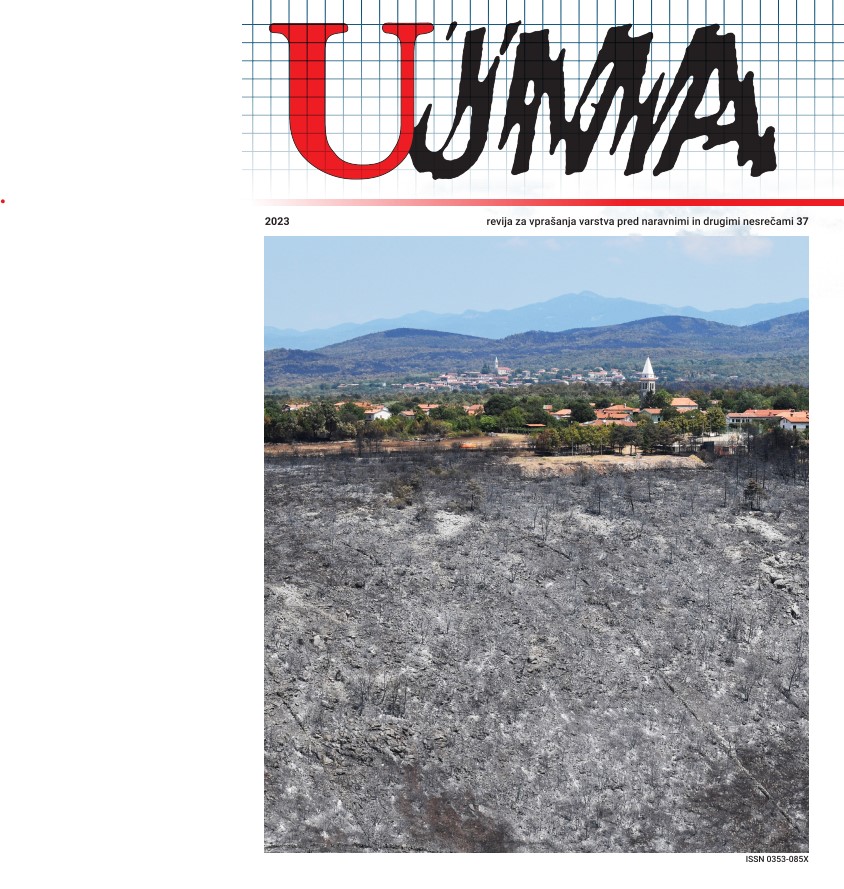DETECTION OF EARTH TIDES BY THE SEISMOMETERS OF THE SLOVENIAN NATIONAL SEISMOLOGICAL NETWORK
Abstract
The ground beneath our feet moves every day, often by as much as 30 centimetres, but this is not caused by earthquakes or the movement of tectonic plates; it is the result of the gravitational forces of celestial bodies, especially the Moon and the Sun. This movement is the tides of the Earth‘s crust, and is also recorded by the sensitive broadband seismometers of the Slovenia National Seismological Network. Despite the fact that seismometers are not designed to record such long-period ground movements, by combining measurements from the entire network we can correctly record the tides of the Earth‘s crust in Slovenia. With the help of theoretical information about the Earth tides, we can also identify disturbances in the operation of the seismometers or the influence of the structure of individual seismic stations on seismological measurements.
References
Agnew, D. C., 2007. Earth Tides, Treatise on Geophysics: Geodesy, T. A. Herring, ed., Elsevier, New York, 163–195.
Agnew, D. C., 2005. Earth Tides: An Introduction. https://www.unavco.org/education/professional-development/short-courses/course-materials/strainmeter/2005-strainmeter-course-materials/tidenote.pdf, 28. 5. 2023.
Agnew, D. C., 1986. Strainmeters and tiltmeters, Rev. Geophys, 24, 579−624.
Agnew, D. C., Wyatt, F. K., 2003. Long-base laser strainmeters: a review, SIO Technical Report, 2. https://repositories.cdlib.org/sio/techreport/2/, 28. 5. 2023.
Alterman, Z., Jarosch, H., Pekeris, C. L., 1959. Oscillations of the earth. Proc. R. Soc. Lond 252, 80–95.
Christodoulidis, D. C., Smith, D. E., Williamson, R. G., Klosko, S. M., 1988. Observed tidal braking in the Earth/Moon/Sun system. J Geophys Res Solid Earth 93, 6216–6236.
Greene, C., 2023. Sold Earth Tide Predictions. https://www.mathworks.com/matlabcentral/fileexchange/50327-sold-earth-tide-predictions, MATLAB Central File Exchange, 28. 5. 2023.
Hinderer, J., Amalvict, M., Crossley, D., Leveque, J. J., Rivera, L., Luck, B., 2002. Tides, earthquakes and ground noise as seen by the absolute gravimeter FG5 and its superspring; comparison with a superconducting gravimeter and a broadband seismometer, Metrologia 39 495, DOI 10.1088/0026-1394/39/5/11.
LaCoste, L., 1988. The zero-length spring gravity meter. The Leading Edge, 7 (7): 20–21.
Marson, I., 2012. A Short Walk along the Gravimeters Path. International Journal of Geophysics, vol. 2012. https://doi.org/10.1155/2012/687813.
Milbert, D., 2018. Solid Earth Tide. https://geodesyworld.github.io/SOFTS/solid.htm, 28. 5. 2023.
NOAA, 2023, Are tides higher when the moon is directly overhead? https://oceanservice.noaa.gov/facts/moon-tide.html, 28. 5. 2023.
Ostrihansky, L., 2019. Summary of the most evident tidal actions on solid Earth. 10.13140/RG.2.2.22859.95529.
Pavlovčič Prešeren, P., Kuhar, M., 2015. Modeliranje plimovanja trdne Zemlje za geodetsko določanje 3D položaja točk kombinirane geodetske mreže, Raziskave s področja geodezije in geofizike 2015, Fakulteta za gradbeništvo in geodezijo, 93–102.
Ruotsalainen, H., 2001. Modernizing the Finnish long water-tube tilt meter. Journal of the Geodetic Society of Japan, 47(1), 28–33.
Tasič, I., 2019. Triosni širokopasovni seizmometri s postavitvijo senzorjev XYZ in UVW. Ujma 33, 2019, 185–191.
USGS, 2023. Can the position of the moon or the planets affect seismicity? Are there more earthquakes in the morning/in the evening/at a certain time of the month? https://www.usgs.gov/faqs/can-position-moon-or-planets-affect-seismicity-are-there-more-earthquakes-morningin-eveningat, 28. 5. 2023.
Vidrih, R., Sinčič, P., Tasič, I., Gosar, A., Godec, M., Živčić, M., 2006. Državna mreža potresnih opazovalnic, ur. Vidrih, R., Agencija RS za okolje, Ljubljana.
Downloads
Published
Issue
Section
License

This work is licensed under a Creative Commons Attribution-NonCommercial-NoDerivatives 4.0 International License.
The articles are made available to the public under Creative Commons Attribution-NonCommercial-NoDerivatives 4.0 International (CC BY-NC-ND 4.0).


